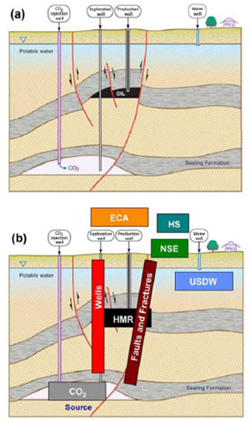|
 |
|
Generic Geologic Cross Section of Potential GCS Site Showing Reservoir and Confining Zones, Faults, Wells, USDW, and Near-Surface and Surface Environments; (b) Generic Cross Section with CF Source and Compartments Overlaid |
No known contamination of groundwater has occurred from CO2 injection. However, unintended CO2 release, either from wells or along faults and fractures, could impact groundwater quality. Increases in dissolved CO2 concentration that might occur if CO2 migrates from a storage reservoir to the surface would alter groundwater chemistry, potentially affecting shallow groundwater used for potable water and industrial and agricultural needs. Dissolved CO2 forms carbonic acid, altering the pH of the solution and potentially causing indirect effects, including mobilization of metals, sulfate, or chloride, and possibly giving the water an odd odor, color, or taste. In the worst case, byproducts of CO2 migration into groundwater resources might reach dangerous levels, excluding the use of groundwater for drinking or irrigation. Another potential consequence of geologic storage of CO2 arises from displacing salty brines from the storage formation into an adjacent freshwater geologic formation. In the unlikely event that this happened, it could degrade the quality of the formation, potentially limiting beneficial uses. Well planned storage projects will take the potential impacts of brine displacement into consideration as part of the site selection process. Major factors to be considered include the size of the storage formation and regional hydrologic conditions. For hydrologic conditions typical of regional scale storage formations, if the volume of CO2 is small compared to the volume of the reservoir, the likelihood of impacts on brine displacement is low, because the volume of brine displaced by CO2 can be accommodated by a small pressure increase over the extent of the storage formation.
| Myth: |
When CO2 is injected underground, it is likely to contaminate drinking water. |
| Reality: |
When CO2 is injected underground, it is injected at depths greater than one-half mile. Drinking water is usually found at depths of less than several hundred feet. Impermeable caprock is found between these two depths. In addition, it is important to note that no known contamination of groundwater has occurred from CO2 injection as of February 2011. |
|